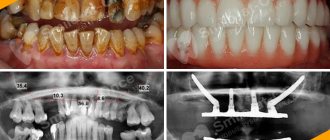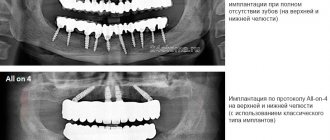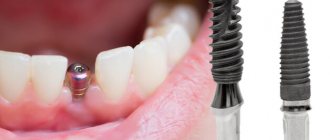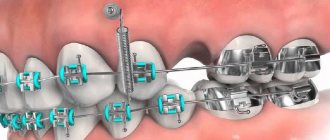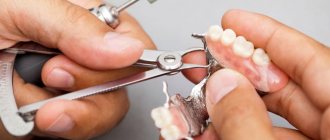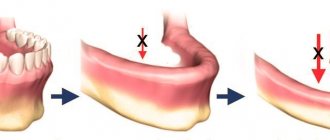From this article you will learn:
- what is zygomatic implantation,
- what complications can there be,
- patient reviews of zygomatic implants.
The article was written by a practicing implantologist.
Zygoma zygomatic implants are a solution for patients with complete absence of teeth in the upper jaw (in the presence of a critical degree of bone volume loss), which allows them to obtain a permanent prosthesis and at the same time do without bone grafting. We will use them in situations where we do not have enough bone volume in the lateral areas of the upper jaw to install conventional classic dental implants.
How do zygomatic implants differ from traditional dental implants? First of all, the fact that zygomatic implants are significantly longer (there are options from 30 to 52.5 mm), and they are fixed mainly in the zygomatic bone. But these implants should not be used in all patients, and should only act as a “last alternative to bone grafting.” This is due to the high complexity of their installation, and the potential risk of complications (if the implant surgeon does not have sufficient experience in maxillofacial surgery).
Zygomatic implantation (on the diagram and RG image) –
Nobel Zygoma implants are developed by ]Nobel Biocare[/anchor] (Switzerland), which is one of the most famous manufacturers of dental implants in the world. It was this company that developed such implantation methods as “All-on-4” and “All-on-6”, which allow patients with complete absence of teeth in the jaw to receive a completely permanent prosthesis (on 4 or 6 implants , respectively). Moreover, the prosthesis is fixed already 2-3 days after the operation.
It is for the All-on-4 and All-on-6 techniques that special implant models were developed, for example, “Nobel-Speedy Groovy”, “Nobel-Parallel CC”, as well as “Nobel-Zygoma” zygomatic implants. The latter are truly unique, because... no implant manufacturer offers anything like this, but as we said above, these implants should be used only as a last resort. And there are reasons for this.
What is zygomatic or transzygomatic dental implantation: a complete overview of the modern method
Article navigation
- What is the essence of the method and installation features
- Advantages and features of the technology
- What brands of extended implants are used?
- What prostheses can be installed on implants?
- Complexes that use zygomatic implants
- FAQ
Question for a specialist
Zygomatic or, as it is also called, transzygomatic dental implantation is a relatively new technique for restoring a smile in conditions of partial or complete absence of elements of the upper dentition. This is an option that can be saved in cases where there are acute atrophic processes in the thickness of the bone tissue of the upper jaw, in particular in the area of the chewing teeth. This problem always arises when a person delays treatment too much, and also wears a removable prosthetic device or “bridge” for a long time. From this article you will learn what the essence of this technique is, what its pros and cons are, in what cases such designs are used, and also what are the features of the Zygoma, Zygomatic or similar implants - the most popular for implantation into the zygomatic bone skulls
Feature: to restore a segment, 1-2 zygomatic implants are used, for a full jaw - at least 2 pieces, maximum - 4 pieces. In total, from 4 to 6 or even more implants are placed per row, some of which are zygomatic. Suitable for the upper jaw only. The prosthesis is placed immediately.
Treatment period: 3-5 days.
The main characteristic of the technique is that zygomatic implantation involves the use of special root substitutes - special elongated implants implanted deep into the skull bone, which is not subject to atrophy. Such models can reach 60 mm in length - it is thanks to this feature that they allow you to avoid the procedure of bone grafting and sinus lifting. Apply only to the upper jaw. In the absence of contraindications, the orthopedic system is fixed directly on the day of the procedure or a couple of days after.
Photo of Zygoma implants from Nobel Biocare
For front teeth
Implants for the anterior regions must meet high requirements, and therefore they must be selected as carefully as possible. Primary requirements:
- optimal length and compact diameter for easy implantation;
- made of zirconium dioxide, so they will not show through the gums;
- Different sized threads at bottom and top for stability.
By choosing a suitable implant, a specialist can preserve the maximum amount of bone tissue, avoiding its loss. When working in the smile zone, a one-stage version of the procedure is used with the use of a temporary prosthesis or crowns on the day of implantation.
What is the essence of the method and features of installing elongated implants?
The zygomatic bone (zygomaticum in Latin - hence, in fact, all the names of such implants) is adjacent to the frontal and temporal regions. It is characterized by increased density and strength, due to which it remains reliably protected from aggressive atrophic processes. When used as part of implant treatment, it is possible to achieve the highest levels of primary stability even in conditions of acute and sometimes extreme atrophy of the bone tissue of the upper dentition. This makes it possible to restore the upper chewing teeth also in case of osteomyelitis - a purulent-necrotic process that develops in bone tissue and bone marrow.
As noted above, the essence of this technique comes down to the implantation of elongated implants in atrophied areas. Their installation is carried out at a slight angle, and this is also no coincidence. This type of fixation allows you to bypass the nasal sinuses (often such models border on its shell, but in no case pass through it), eliminate the risk of damage to the facial nerve, and also increase the number of points of contact between the implant and the bone tissue. In addition, most of the structure appears in the thickness of the zygomatic bone, which significantly improves the quality and strength of the structure’s fastening.
From the history of creation: zygomatic implants were first introduced to the world back in the late 80s of the last century. True, in those years such elongated rods were used mainly as part of the rehabilitation treatment of patients with serious problems of the upper jaw, that is, when the bone was severely destroyed as a result of injury or oncology. Later, they began to be used as part of the restoration of damaged teeth and for other patients, as an alternative to the expensive and painful sinus lift - osteoplastic surgery on the upper jaw.
In the process of installing such structures, doctors use angular multi-unit abutments, which allow the prosthesis to be secured with screws - this makes it possible to align their position with the level of the mucosa. In other situations, models with a beveled edge can be used for this, and then traditional straight abutments are used, but even in this case, the specialist leaves the option of fixing the prosthesis using a screw method.
It should be immediately noted that this implantation technique falls into the category of one-stage treatment protocols. That is, after implantation of artificial roots, a dental prosthesis with an individual metal frame can be fixed. The structure is installed directly on the day of surgery or literally a few days later - it all depends on individual indications. This makes it possible for the patient to literally instantly return to a full life - after a week he will be able to talk and eat normally, gradually increasing the intensity of the chewing load.
An important feature of the prosthesis is that, as in other similar protocols, it acts as a stabilizer. That is, a metal base connects the tops of the implants, due to which the structures are stationary. This system visually resembles a regular bridge.
Where did the name of the technique come from?
Zygomatic implantation can hardly be called a separate method of tooth restoration; rather, it is a unique addition to those implantation protocols with immediate loading of a prosthesis, which allow, without the use of bone grafting, to get new teeth in just a few days, smile without problems, and eat well. But this improvement only applies to the upper jaw.
As some may have already guessed, zygomatic implantation somehow involves the zygomatic bone. Indeed, the zygomatic bone (translated from Latin zygomaticum) is a bone that directly connects to the frontal and temporal parts of the skull. And also with the upper jaw. These are very deep and dense layers; they never succumb to atrophic processes, unlike spongy bone (it is the center of the jaw bone). In addition, they are not subject to inflammation due to periodontitis or periodontal disease.
Having found this out, the world's leading implantologists came to the conclusion that the use of this particular part of the bone during implantation will be the only way out for tooth restoration for many patients. By that time, special intraosseous zygomatic implants had already been created and actively used in implantology, which helped solve the problem for patients with jaw injuries and cancer patients. So the models, due to their unique characteristics, have become widespread. And we moved from solving complex clinical cases to ordinary patients. True, there are still restrictions to this day.
Advantages and features of the technology
The implant technology under consideration opens up a lot of opportunities for quick and high-quality smile restoration, and also allows you to achieve undoubtedly aesthetic and at the same time durable results. Among the key advantages of this method, experts in the field of dental implantology highlight the following points:
- speed of obtaining results - from the moment of implantation to the installation of the prosthesis, a maximum of a week passes, in fact, in one day you can completely restore the functionality and aesthetics of the dentition,
- refusal of sinus lifting - due to the fact that the cranial bone is also involved, and not just the jaw bone, and also due to the slight inclination of the root substitutes themselves, it is possible to achieve excellent indicators of primary stability, which makes it possible to abandon bone grafting, which significantly increases the duration and the cost of treatment,
- thorough study of all stages of implantation using specialized software - in preparation for the operation, 3D modeling techniques are used. Modern software allows for complete planning based on a three-dimensional model of the patient’s jaws: the exact places for implantation of artificial roots are determined, and individual surgical templates (stencils) are prepared, which are applied to the gums at the time of the operation and allow implants to be installed exactly in the places where was planned, without even a millimeter error,
The planning stage, and a computerized one, is an important and mandatory stage - in no case should you be guided only by a panoramic, not a three-dimensional image. This is fraught with improper installation of implants, damage to the maxillary sinuses, or, even worse, injury to the orbital region and nerve endings. Zygomatic implantation is a fairly serious treatment protocol that should not be carried out by just any implantologist. Only experienced maxillofacial surgeons should be allowed to perform treatment, and nothing else.
- the highest aesthetic characteristics of the orthopedic design - the prosthetic device, which is fixed after the implantation of root analogues, has a fairly rigid metal base that hides an acrylic base that imitates gums. Crowns can be made of metal-plastic or ceramic composite (at the first stage) - this makes the structure lightweight so as not to disturb the positioning of the implants, and at the same time externally natural and fully functional. And when the implants fully fuse with the bone, you can choose a more aesthetic version of prostheses - from absolutely any materials, if your finances allow it,
- a minimum number of contraindications - with such an implant system, it becomes possible to restore teeth even with critical bone atrophy, against the background of periodontitis, periodontal disease and osteomyelitis - this area of the bone is not afraid of either resorption or inflammatory processes.
The patient’s story is a real review posted on the website of one of the Moscow dental clinics: “I would like to say a big thank you to the specialists of Clinic N. As far as I understand, in my case, long implants from Nobel became a real salvation. For more than 10 years I lived with a regular removable denture instead of my upper teeth, and I had almost none of my own left. When I decided to thoroughly engage in implantation, it turned out that everything was not so simple. X-rays showed that the bone tissue under the prosthesis had severely atrophied, and the implants simply could not be fixed. I began to study this issue and was horrified when I found out how bone grafting is performed and how much it costs. Friends recommended your clinic, and only here they told me in detail and explained that now I can do without this operation. So I had a complete restoration of the upper jaw, without any additional procedures. And about 5 days later they installed a denture with brand new beautiful teeth - isn’t this fantastic?!”
Boris Leonidovich S., Moscow, 58 years old
- excellent indicators of primary stability - again, due to the use of skull bone, the risk of displacement and loss of artificial dental roots remains at a very minimal level. The stabilization rate varies from 60 to 100 newtons, whereas with the classical approach it is two times lower,
- protection against peri-implantitis (rejection) and a guaranteed long-lasting result - these characteristics are due to the fact that in the zygomatic part of the skull the bone is denser and is not susceptible to inflammation,
- more possibilities for prosthetics - the process of osseointegration, that is, the fusion of the implant body with bone tissue, takes on average about six months to a year, however, in the case of instant loading methods, a temporary (adaptation) prosthetic device can be fixed almost immediately. Upon completion of osseointegration, the patient will be able to install any aesthetic system, be it a metal-ceramic or zirconium oxide option.
For example, as a result of clinical studies) - a leader in the production of implants and their components - it turned out that the survival rate of their branded extended implants Zygoma (“Zygoma”) reaches 95.2% over a 10-year period . According to the assurances of practicing experts, the manufacturer slightly underestimated the figures, since if all manipulations are carried out well, the real figure reaches 98%[ii]. However, this is explained by the fact that such models are used in difficult situations, and here the indicators are actually somewhat lower than if the patient has good bone quality and excellent health.
In general, intraosseous implantation protocols with the possibility of immediate loading with a prosthesis give patients the opportunity to quickly regain their smile – beautiful and functional. As a result, small wrinkles resulting from prolonged absence of teeth gradually smooth out. Thus, we can safely talk about the additional effect of rejuvenation.
Progress of the procedure
The key to successful surgical intervention is a highly qualified specialist and thorough preliminary diagnostics (laboratory and instrumental). It allows you to identify possible contraindications and correctly plan the procedure. At the initial appointment, the doctor collects anamnesis and carefully examines the condition of the patient’s oral cavity. Next, blood donation, orthopantomogram and computed tomography are prescribed. Implantation consists of the following stages:
- 3D modeling of the jaw. It allows you to create an accurate model of the patient's jaw, providing detailed information about the anatomical features.
- Preparing tooth sockets.
- Removal of remaining teeth (if required).
- Selecting the design of the prosthesis, establishing the number of required implants, their size and location.
- Carrying out implantation. The surgery is performed under local anesthesia or sedation, so the patient does not experience pain. After this, the specialist makes small incisions, implants and strengthens the implants. The total duration of the process is about 90 minutes.
- Installation of a temporary structure (provides immediate load on the jaw).
- Manufacturing of a permanent structure.
- Installation of a permanent structure.
After the end of the surgical intervention, slight swelling is possible, which goes away on its own in the near future. If necessary, the doctor may prescribe antibiotics and antiseptics. It is important to maintain oral hygiene. Every six months you are required to make an appointment for examinations so that the doctor can monitor the patient’s condition.
What brands of extended implants are used today?
Today, there are several brands on the market of modern implantological systems, under which models for implantation into the zygomatic bone are produced. All of them are united by an elongated body, which is designed for fixation in the deep layers of the bone tissue of the skull. We asked a specialist from the Smile-at-Once dental center, a clinic that was one of the first in Russia to offer the possibility of using one-stage treatment protocols, to clarify some points about the features of such models of artificial roots. This is a doctor who, in fact, was the first in our country to start working with this protocol, that is, for more than 22 years. Today he not only practices medicine, but also trains Russian specialists, and has many scientific papers and patents.
The table below shows the main brands of zygomatic implants with brief explanations of the indications for their use and installation features.
On a note! We would like to immediately draw your attention to the fact that zygomatic implants are often called “Zygoma” or “Zygoma”. But this is not entirely correct. In fact, this name has already become a household name, because it is nothing more than the name (and patented) of a model from the Nobel company, which was the first to introduce such zygomatic implants to the world. Other brands, accordingly, have their own names.
| Model name and manufacturer | Brief comment |
| Zygoma from Nobel Biocare | Nobel Biocare introduced the world's first model, called Zygoma. The size of such an implant can reach 5.2 cm, the diameter is 4.2 mm. The manufacturer offers 2 options for the Zygoma system: with a straight and angular platform, as well as with threads along the entire height or only in the top area. The patented TiUnit coating promotes accelerated osseointegration. |
| Zygomatic from Southern Implants | They are characterized by high long-term survival rates. The developer focuses on the production of implants with a beveled edge for fixation at an angle, which eliminates the use of angled abutments, and this is an additional saving, since straight designs are slightly cheaper. As of 2021, this brand is not used in Russia, as it has not yet been certified. |
| Zygomatic (Zygomatik) from Noris Medical | Zygomatic (“Zygomatic”) from the Israeli company Noris Medical - a model with an active thread in the upper edge and a smooth coating on the rest of the surface - does not allow bacteria to accumulate and serves as a prevention of inflammatory processes. The brand is relatively young, so it does not yet have reliable results from clinical studies - this needs to be taken into account. |
| Transzygomatic implants from Biomed | The models presented by Biomed are used within the framework of basal implantation - one-piece structures with a smooth neck and an antibacterial layer on the surface. |
| ZygoLine (“ZigoLine”) from Radix (Belarus) | Despite the fact that the Belarusian company has existed for more than 20 years, only in recent years has it begun to gain popularity in our country. The range includes models for both classical implantation and immediate loading. Including zygomatic implants. As experts note, the quality of the products is at a very high level, while the prices are very affordable and do not depend on strong currency fluctuations. |
What prostheses can be installed on Zygoma and Zygomatic implants
Despite the fact that one-stage implantation is a one-stage protocol, there will still be two stages of prosthetics (if you do not choose a permanent prosthesis right away, but this will be more expensive). As a rule, immediately after the implantation of root substitutes or within a week at most, the artificial roots can be loaded with an adaptive orthopedic construction with artificial teeth. Lightweight devices with a metal frame are used.
Expert opinion
Put Vladimir Anatolyevich “The presence of a strong beam in the structure has a kind of splinting effect. Instant loading with a prosthesis is not just an aesthetic whim, but an important functional necessity, since the metal frame allows you to stabilize the implants, fix them in the desired position and eliminate the risk of their displacement. As a result, the patient receives not only a new beautiful smile, but also the ability to chew food and speak normally. In addition, the chewing load stimulates metabolic processes in bone tissue, which ensures rapid osseointegration of implants.”
The prosthesis is secured using screw fixation - small screws are screwed directly into the abutments through the tops of the crowns. This greatly simplifies the removal of the structure if it needs to be adjusted - a consequence of bite deformation after installation of implants and the rehabilitation period. The service life of such a device is about 3-5 years, it all depends on the materials. In particular, the metal-plastic system “works” for so long. But if you choose a ceramic composite, then its service life is practically unlimited - about 15-20 years. Such a prosthesis will cost more, but in fact, you really get new teeth once and for all.
One-stage implantation
This version of the procedure is known as Immediate Load. The installation of crowns occurs immediately after implantation of implants and fastening of abutments. The duration of treatment is several days, but this is only relevant for those cases when there is no need to treat gum inflammation, treat or remove nearby teeth and eliminate other problems.
Key stages:
- Diagnosis of the patient’s teeth, gums and general health, testing, orthopantomogram and computed tomography examination.
- Selecting the optimal location for installing implants with the production of special templates.
- Implantation (approximately 30 minutes).
- Making impressions for the production of prostheses.
- Installation of crowns using a screw or glue.
Complexes that use zygomatic implants
Extended implant models are used as part of various one-stage treatment protocols. One can even say that transzygomatic implantation cannot be classified as an independent method, because it only serves as an addition to other methods for restoring partially or completely lost teeth. The table below shows protocols, the use of which may involve the use of such models.
| Protocol | Comments | Approximate cost, rub. / 1 jaw |
| Restoration of a tooth segment | To restore a group of chewing teeth, 2 artificial roots are used in different combinations: either 1 zygomatic and 1-2 classic with direct installation / 2 zygomatic / 2 zygomatic and one regular. It all depends on the situation - the specific decision is up to the doctor. | About 200,000 rubles |
| All-on-4 | Nobel's protocol - for complete restoration, 4 root substitutes are attached, and two of them or all four at once can be zygomatic. Due to more reliable and durable fixation, treatment can be carried out in conditions of emergency bone atrophy, even in the lateral regions. It is advisable to carry out such a protocol only on Nobel models | From 500 to 600 thousand rubles using 2 and 4 zygomatic implants, respectively, including a basic prosthesis |
| All-on-6 | 6 implants are implanted, 2 or 4 of which can be zygomatic - relevant for cases of acute lack of jawbone height in the distal sections. At the same time, there must be sufficient bone tissue left in front to fix two classic implants | From 600 thousand, subject to the use of 2 zygomatic models and with fixation of a permanent prosthesis |
| Basal complex | Up to 12 dental implants are used, with the lateral ones being fixed in the deep layers of the jaw bone, or also using the zygomatic bone. The method is optimal for cases of inflammation of periodontal tissues and acute atrophy. Biomed brand models are used here. | From 250 to 300 thousand for 8-12 implants with the installation of a permanent adaptation “bridge” |
The prices given in the table are based on the complete restoration of one jaw in Moscow. Prices are approximate, since the exact cost of the entire treatment will depend on many third-party factors: from the number of teeth to be restored, to the region of treatment and the pricing policy of the dental center.
Contraindications
The list of reasons that prevent the installation of zygomatic or pterygoid implants is small. They can be installed after chemotherapy, for hepatitis and HIV. Each case is considered separately. Sometimes contraindications are relative.
Relative
the procedure can be carried out with extreme caution
- Infections;
- upper respiratory tract diseases;
- sinusitis;
- smoking;
- oncological diseases at the stage of active treatment;
- pregnancy;
- age up to 18 years.
Absolute
the procedure is strictly prohibited
- Autoimmune diseases;
- paralysis;
- mental disorders;
- intolerance to anesthesia.
Frequently asked questions with detailed answers
The technique in our country, although not new, is not used so often, so a lot of questions inevitably arise. To dispel all your doubts about the effectiveness and safety of using zygomatic models, we have provided detailed explanations of the most frequently asked questions from patients.
How do Zygoma and Zygomatic differ from classic implants?
Such dental implants differ from classical models primarily in their length, which in some cases can reach 6 cm. Such implants are not implanted into the jaw bone, but much further into the zygomatic part of the skull, which makes it possible to achieve excellent primary stability even with severe bone tissue atrophy jaws.
There are also differences between the concepts of Zygoma and Zygomatic - they belong to different brands. Zygoma is the patented name for zygomatic models from Nobel.
What are the disadvantages of zygomatic implantation?
The main disadvantage of this technique, as, indeed, of all one-stage treatment protocols, is the acute shortage in Russia of qualified personnel with the necessary experience and necessary knowledge to carry out this type of operation. Such procedures can only be performed by experienced maxillofacial surgeons with skills in working in special computer 3D modeling programs and with certificates of additional training from manufacturing companies of modern implantological systems. As for zygomatic implants specifically, another obvious drawback of these models is their high cost - the use of such root substitutes as part of complex protocols makes treatment much more expensive.
In what cases is the use of such implants indicated?
Extended implants can be used to replace part of the chewing teeth in the upper jaw, as well as in cases of complete or almost complete edentia as part of a complex restoration. They are also still actively used to treat victims of serious accidents, patients with severe injuries and oncology. This is an excellent solution for extreme atrophic processes in bone tissue in the distal parts, for inflammation, as well as for people in old age, in which severe bone atrophy is a natural consequence of the aging of the body. Such models also save in cases where sinus lift is contraindicated for the patient.
How long do implants last?
Let us remember that this concept was developed with the expectation of treating seriously ill patients with severe facial injuries, therefore such implants are focused on maximum service life. In this case, we can safely talk about lifelong use, especially since after 5-10 years the patient can always replace the prosthetic structure with a newer and more aesthetic one.
What complications can there be?
The risk of complications after implantation of zygomatic implants is reduced to a very minimum since only highly qualified specialists with extensive experience, necessary skills and knowledge are allowed to perform such operations. In addition, each stage of treatment is carefully worked out using 3D modeling, which eliminates all potential errors. A complication in the form of peri-implantitis, that is, rejection of a dental implant, can only develop as a result of unscrupulous preparation for surgery, violations of implantation technology, or the patient’s failure to comply with doctor’s instructions in the postoperative period. That is, in fact, the use of these implants is no different from the use of other models, if the doctor performed the operation correctly and the patient follows all the recommendations.
Are there any alternatives?
As an alternative solution to the problem, you can consider the option of removable prosthetics or installing a bridge structure. Only here it is necessary to understand that atrophic processes will continue to destroy bone tissue, and this will eventually lead to subsidence of the prosthesis, and it will have to be systematically repositioned.
Perhaps the only method that can compete with zygomatic implantation is the Basal Complex - complete restoration of the jaw using 8-12 dental implants, including special basal models with a smooth antimicrobial coating for cases of inflammatory processes. But zygomatic implants can also be used here, so this is not to say that this is a completely alternative - however, the models are already of a slightly different shape than traditional Zygoma.
Based on long-term clinical studies conducted by Nobel Biocare.
[ii] L. Chong, A. Khocht, J. B. Suzuki and J. Gaughan, “Effect of implant design on initial stability of tapered implants,” The Journal of Oral Implantology, vol. 35, pp. 130–135, 2009.
Author: Namdakov N.V. (Thank you for your help in writing the article and the information provided)
Prices
| Service | Price |
| One-stage complex implantation for completely edentulous one jaw, including an adaptive prosthesis (combination of 6-12 COMPRESSIVE, BASAL implants of the ROOTT system (Switzerland, Trate AG) on a metal frame with cement fixation. | from 265,000 rub. |
| One-stage complex implantation for completely edentulous one jaw, including an adaptive prosthesis (combination of 6-12 COMPRESSIVE, BASAL implants of the ROOTT system (Switzerland, Trate AG) on a titanium frame with cement fixation | from 295,000 rub. |
| One-stage complex implantation for completely edentulous one jaw, including an adaptive prosthesis on a titanium frame supported by 6-12 implants of the ROOTT system (Switzerland, Trate AG) multi-unit with screw fixation | from 325,000 rub. |
| One-stage complex implantation for completely edentulous 1 jaw, including a ceramic-composite prosthesis, put on on days 3-4, a combination of 6-12 screw-fixed implants, ROOTT system (Switzerland, Trate AG). No re-prosthetics required | from 580,000 rub. |
Consultation and diagnostics are free!
All prices Promotions
